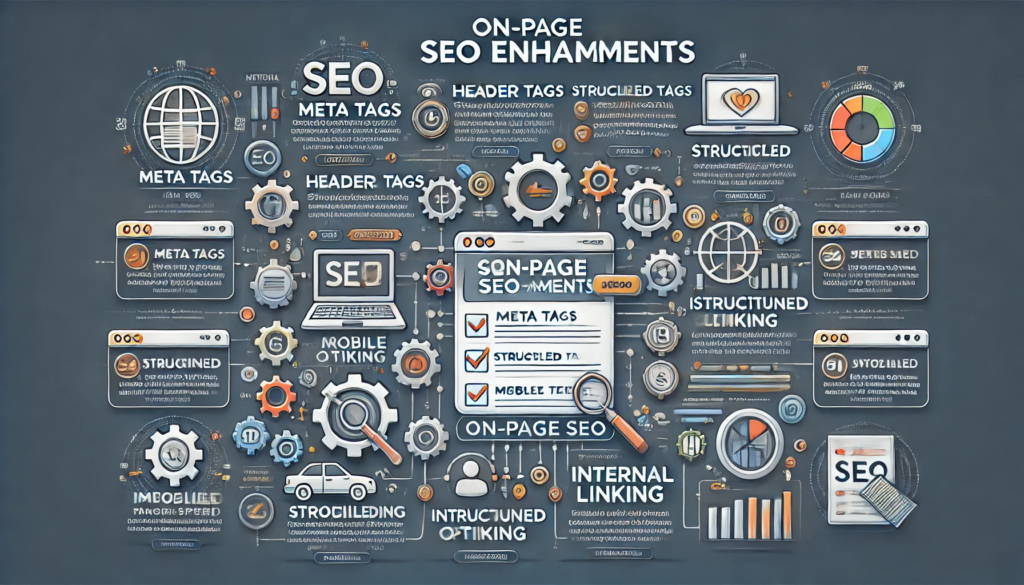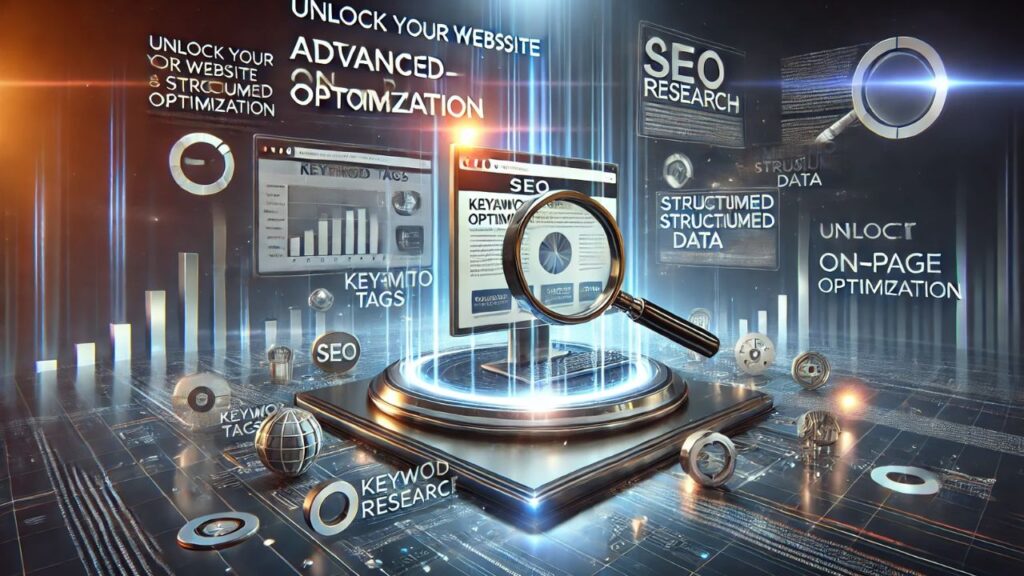In the ever-evolving digital world, optimizing a website for search engines requires more than just incorporating keywords and building backlinks. Advanced on-page optimization is crucial in improving visibility, enhancing user experience, and increasing organic traffic. By implementing refined strategies, websites can align with search engine algorithms while providing value to visitors.
This guide explores the core elements of advanced on-page optimization, offering practical insights into improving website structure, content, and technical aspects to achieve sustainable search engine rankings.
Table of Contents
Understanding On-Page Optimization
On-page optimization refers to the techniques used within a website to improve its ranking in search engine results pages (SERPs). Unlike off-page SEO, which involves external factors like backlinks and social signals, on-page optimization focuses on optimizing content, HTML source code, and site architecture.
Advanced on-page optimization extends beyond basic elements such as meta tags and keyword placement. It involves a deeper analysis of user behavior, search intent, and technical enhancements that contribute to a seamless browsing experience.
Keyword Strategy for Enhanced Relevance
Optimizing for Search Intent
Modern search algorithms prioritize content that aligns with user intent. Understanding search intent helps in structuring content that meets the needs of visitors. The four main types of search intent are:
- Informational: Users seek answers to queries (e.g., “how to optimize a website”).
- Navigational: Users look for a specific website or page (e.g., “Google Search Console login”).
- Transactional: Users intend to complete an action (e.g., “buy SEO tools online”).
- Commercial Investigation: Users compare options before making a decision (e.g., “best keyword research tools”).
Incorporating keywords based on intent ensures content aligns with what users are looking for, improving engagement and ranking potential.
Semantic Keyword Integration
Search engines now recognize context rather than just individual keywords. Using latent semantic indexing (LSI) keywords and related terms enhances content relevance. These variations provide depth and clarity, allowing search engines to understand content without excessive repetition of primary keywords.
For example, a page optimized for “on-page SEO techniques” can also include terms like “technical SEO improvements,” “content optimization,” and “website structure enhancements” to reinforce relevance.
Natural Keyword Placement
Keyword stuffing can lead to penalties and diminish user experience. Instead, keywords should be integrated naturally into:
- Title tags and meta descriptions
- Headings (H1, H2, H3)
- URL structure
- Image alt text
- First 100 words of the content
- Internal links and anchor texts
Maintaining a natural flow ensures readability while signaling relevance to search engines.
Content Optimization for Maximum Engagement
Structuring Content for Readability
A well-structured page improves engagement and reduces bounce rates. Key elements include:
- Short paragraphs and clear headings: Improves readability and skimmability.
- Bullet points and numbered lists: Helps break down complex information.
- Bold and italicized text: Highlights important details.
A logical content structure allows both users and search engines to navigate information efficiently.
Optimizing Title Tags and Meta Descriptions
Title tags and meta descriptions influence click-through rates (CTR). Best practices include:
- Title Tags:
- Keep within 50-60 characters.
- Place primary keywords near the beginning.
- Use compelling language to attract clicks.
- Meta Descriptions:
- Keep within 150-160 characters.
- Summarize page content clearly.
- Include a call to action (e.g., “Learn more today!”).
These elements serve as the first impression in SERPs, making them critical for driving traffic.
Leveraging Header Tags for Hierarchical Clarity
Header tags (H1, H2, H3, etc.) provide structure and hierarchy. Best practices include:
- H1: Used for the main page title (only one per page).
- H2s and H3s: Used for subheadings to organize content.
- Keyword Usage: Naturally incorporate keywords where relevant.
A well-structured hierarchy improves readability and enhances SEO performance.
Content-Length and Depth Optimization
Comprehensive content generally ranks higher in search results. While there is no universal word count, long-form content (1,500+ words) often performs better for competitive keywords.
- Cover topics in-depth to provide value.
- Use relevant data and sources to add credibility.
- Ensure conciseness and clarity to maintain engagement.
Longer content should remain engaging, avoiding unnecessary repetition.
Technical On-Page SEO Enhancements

URL Structure Optimization
A well-structured URL enhances usability and SEO. Best practices include:
- Keep URLs concise and descriptive.
- Use hyphens (-) instead of underscores (_).
- Avoid unnecessary parameters and numbers.
- Include primary keywords naturally.
For example, example.com/advanced-on-page-seo is more effective than example.com/page123.
Image Optimization for SEO and Performance
Images contribute to engagement but need optimization for faster loading and search visibility. Best practices include:
- Use descriptive file names: (e.g.,
on-page-seo-guide.jpg). - Add alt text: Helps search engines understand the image.
- Compress images: Reduces file size for faster loading.
- Use next-gen formats: (e.g., WebP) for better performance.
Proper image optimization enhances accessibility and page speed.
Internal Linking Strategy
Internal links establish a clear website structure and help distribute authority across pages. Effective internal linking:
- Guides users to relevant content.
- Helps search engines understand page relationships.
- Increases time spent on site.
Anchor texts should be descriptive yet natural, avoiding generic phrases like “click here.”
Page Speed Optimization
Faster-loading pages contribute to better rankings and user experience. Optimization techniques include:
- Minifying CSS, JavaScript, and HTML.
- Enabling browser caching.
- Using a Content Delivery Network (CDN).
- Optimizing server response time.
Tools like Google PageSpeed Insights help identify performance improvements.
Mobile-Friendliness and Core Web Vitals
Mobile-first indexing means search engines prioritize mobile versions of websites. Key aspects include:
- Responsive design for seamless adaptation across devices.
- Readable font sizes and accessible navigation.
- Optimized touch elements for mobile interactions.
Core Web Vitals metrics (LCP, FID, CLS) also impact rankings, emphasizing user experience.
Advanced Schema Markup for Enhanced Visibility
Implementing Structured Data
Schema markup helps search engines understand content context. Common schema types include:
- Article Schema: Enhances blog post visibility.
- FAQ Schema: Displays frequently asked questions in search results.
- Review Schema: Showcases star ratings.
Using structured data increases the likelihood of rich snippets, improving CTR.
Conclusion
Advanced on-page optimization involves a strategic approach that goes beyond traditional SEO practices. By refining keyword integration, content structure, technical elements, and user experience factors, websites can achieve higher search rankings and better engagement.
Implementing these techniques ensures alignment with search engine algorithms while delivering value to users. Continuous monitoring, testing, and adaptation to algorithm updates remain essential for sustained success.
FAQs on Advanced On-Page Optimization
1. What is on-page optimization in SEO?
On-page optimization refers to the techniques used within a website, including content, HTML elements, and site structure, to improve search engine rankings.
2. Why is keyword placement important for on-page SEO?
Proper keyword placement helps search engines understand content relevance while maintaining readability for users, improving rankings and engagement.
3. How does search intent impact content optimization?
Search intent ensures content aligns with what users are looking for, improving satisfaction, engagement, and search engine visibility.
4. What role do header tags (H1, H2, H3) play in SEO?
Header tags structure content for readability and help search engines understand topic hierarchy, enhancing both user experience and rankings.
5. How can internal linking improve SEO performance?
Internal links guide users to related content, distribute page authority, and help search engines crawl and index pages efficiently.
6. What are Core Web Vitals, and why do they matter?
Core Web Vitals measure user experience factors like loading speed, interactivity, and visual stability, influencing SEO rankings.
7. How can structured data (schema markup) improve search rankings?
Schema markup helps search engines understand content better and increases the chances of rich snippets, improving click-through rates (CTR).
8. Why is mobile-friendliness important for on-page SEO?
Google prioritizes mobile-first indexing, meaning a mobile-friendly website ensures better rankings and an improved user experience.
9. How does page speed affect SEO rankings?
Faster page speed enhances user experience, reduces bounce rates, and is a ranking factor in Google’s algorithm.
10. What are LSI keywords, and how do they help with on-page SEO?
Latent Semantic Indexing (LSI) keywords are related terms that help search engines understand content context, improving relevance without keyword stuffing.



